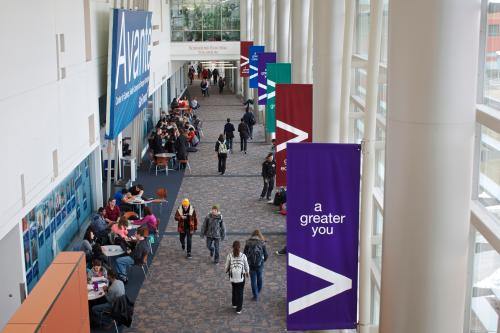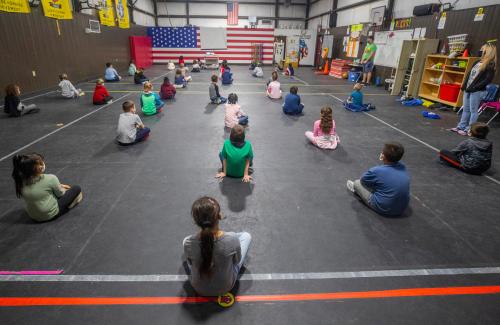Children and families are facing stresses associated with poverty—and a pandemic—that are known to disrupt healthy child development and impede a child’s readiness to learn. This has been a year of economic distress, food lines, job loss, illness, and grief. School and community leaders are eager to mitigate these sources of harm with resources, relationships, and opportunities intended to support children and families.
In a reprieve from Washington’s partisan gridlock, Congress passed three stimulus bills that include over $190 billion for K-12 education, as well as substantial additional investments in child and family well-being. Schools are now historically positioned to transform the hodgepodge of services and programs available to students into powerful systems of learning and opportunity.
As education leaders make plans for recovery, evidence-based comprehensive support models are an allowable use of federal education funds. Comprehensive support models aim to address the out-of-school factors that can impact students’ in-school engagement and readiness to learn. These models have the potential to support student recovery and thriving while improving student academic and social-emotional outcomes. Providing “wraparound” supports can improve student mental health, social-emotional development, and academic learning.
It’s critical to consider evidence on the effects and costs of policy alternatives to ensure public funds are used in the most efficient and complementary ways possible to recover and set a better path forward following the pandemic. To accomplish this, leaders must be thoughtful about how they use public funds. There is enhanced responsibility—and opportunity—to use resources to address the deep and pervasive impacts of the pandemic on children and families. Emerging evidence suggests that well-implemented comprehensive support models can deliver societal benefits that far outweigh their costs.
New research on the benefits and costs of integrated student support
School-based models that address the comprehensive needs of students, also known as integrated student support, provide a “whole child” approach to education and support students’ strengths and needs across all developmental domains. Importantly, these models leverage resources and relationships available in schools and the surrounding community.
One evidence-based model of integrated student support is City Connects, a program incubated at the Boston College Center for Optimized Student Support (where co-author Wasser Gish works). Through City Connects, a student-support staff member serves as a coordinator who works closely with teachers, staff, families, students, and community agencies to ensure delivery of individualized student support plans. The model has been found to significantly improve student academic and social-emotional outcomes, particularly for low-income, Black, Latino, and immigrant students.
A recent paper—published in Prevention Science by co-author Bowden and colleagues from the Center for Benefit-Cost Studies of Education—finds that, for every dollar invested in City Connects and the services and resources to which students and families are connected, there is a return to society of $3. The cost estimate includes all ingredients allocated either directly or indirectly due to City Connects, and the returns reflect earnings, health, crime, and welfare improvements due to increased high school graduation and academic achievement. Because the costs are inclusive of external community services and the benefits do not include social-emotional, family, or teacher outcomes, this estimate is conservative.
The paper contains three important insights for schools and districts as they return from the pandemic and prepare to provide a supporting environment for student learning and healing.
- The approach takes a systematic and preventative approach that is characterized by a universal perspective where all children are served, rather than only those who are presenting in crisis.
- Based on identified strengths and needs in all developmental domains, children are systematically paired with tailored services and supports, which are managed through a data-based approach. The study found that an additional $5,400 worth of services from community partners were leveraged to support well-being and readiness to learn, driving outcomes.
- Through the coordinator, the model is designed to be integrated into the day-to-day fabric of schooling so that the school itself operates more cohesively across efforts to address crisis, trauma, discipline and safety, social-emotional learning, and academics.
The paper highlights these three mechanisms driving the efficiency of the preventative model by being universal, systematic, and integrated as major distinctions between schools with City Connects and comparison schools without.
Today, student support personnel are using these best practices to assist students and families in accessing needed technology, food, school supplies, clothing, child care, activities, and public programs designed to address impending evictions, homelessness, job loss, illness, and more. In Ohio, schools in Columbus, Dayton, and Springfield are implementing evidence-based approaches to integrated student support. In Massachusetts, the school districts of Salem and Springfield use City Connects districtwide, as do some schools in Boston, Lynn, and Everett. A dozen communities are part of a Massachusetts Department of Elementary and Secondary Education district learning network working toward implementing best practices for integrated student support. All are making small changes to student-support personnel roles, modifying student-support team meetings, and using technology—rudimentary or sophisticated—to enable more effective practices that can last beyond the stimulus funding.
In short, districts are making small investments in professional development and systems infrastructure so that large investments in education and comprehensive services will be more effective.
Nationally, many organizations in addition to City Connects have approaches to integrated student support. Community schools include integrated student support as a necessary and powerful component, and President Biden has proposed increasing federal investment in the Full Service Community Schools Program. Integrated student support is a core part of what programs like Building Assets Reducing Risks and Communities In Schools provide. Spanning the political divides, 13 states and Congress are at some stage of policymaking to advance integrated student support.
Now, as the nation begins to emerge from the pandemic, policymakers and education leaders have resources and a roadmap that shows small investments in systems of integrated student support can yield big gains, providing a pragmatic and promising path to recovery.
Brooks Bowden is an assistant professor at the University of Pennsylvania and director of the Center for Benefit-Cost Studies in Education, which recently moved from Columbia University to the University of Pennsylvania. Joan Wasser Gish is director of strategic initiatives at the Boston College Center for Optimized Student Support.





Commentary
Small investments for big gains: Transforming wraparound services into an engine of opportunity
April 26, 2021